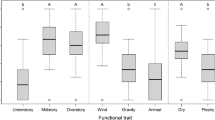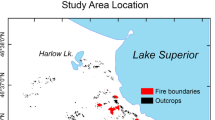Summary
Seed dispersal and seedling emergence of common taxa growing in a Solidago-dominated old field in central New York (USA) were monitored from May 1982 to June 1984. Over 3.5x104 seeds per m2 were captured on seed traps in each of the two years, with peaks occuring in July (due to Hieracium) and in November (due to Solidago). About 4.0x103 seedling/m2 emerged beneath the intact community in each of the two years. Although seedlings emerged predominantly in the early spring, a secondary peak occurred in September and October when many seedlings of introduced grasses appeared. Two additional aspects of the reproductive biology of the major taxa were related to the seasonal timing of seed dispersal: As the date of peak seed dispersal (among taxa) became progressively later in the season, (1) the duration of dispersal increased from about one week to about one-half year, and (2) the delay between the peak of seed dispersal and the peak of seedling emergence increased from a few days to about one-half year.
Similar content being viewed by others
References
Arthur AE, Gale JS, Lawrence KJ (1973) Variation in wild populations of Papaver dubium. VII. Germination time. Heredity 30:189–197
Fagerström T, Ågren GI (1979) Theory for coexistence of species differing in regeneration properties. Oikos 33:1–10
Falinksa K (1968) Preliminary studies on seed production in the herb layer of the Querco-Carpinetum association. Ekologia Polska, Seria A 16:395–408
Fernald ML (1950) Gray's manual of botany. Van Nostrand, New York
Forcier LK (1975) Reproductive strategies and the co-occurrence of climax tree species. Science 189:808–810
Grubb PJ (1976) A theoretical background to the conservation of ecologically distinct groups of annuals and biennials in a chalk grassland ecosystem. Biol Cons 10:53–76
Grubb PJ (1977) The maintenance of species richness in plant communities: the importance of the regeneration niche. Biol Rev 52:107–145
Harper JL (1977) Population biology of plants. Academic Press, London
Harper JL, Clatworthy JN, McNaughton IH, Sagar GR (1961) The evolution of closely related species living in the same area. Evolution 15:209–227
Harper JL, Williams JT, Sagar GR (1965) The behavior of seeds in the soil. I. The heterogeneity of soil surfaces and its role in determining the establishment of plants from seeds. J Ecol 53:273–286
Hyde EOC (1954) The function of the hilum in some Papilionaceae in relation to the ripening of the seed and the permeability of the testa. Ann Bot NS 18:241–256
Marks PL (1974) The role of pin cherry (Prunus pensylvanica L.) in the maintenance of stability in northern hardwood ecosystems. Ecol Monogr 44:73–88
Oomes MJM, Elberse WT (1976) Germination of six grassland herbs in microsites with different water contents. J Ecol 64:745–755
Rabinowitz D, Rapp J (1980) Seed rain in a North American tallgrass prairie. J Appl Ecol 17:793–802
Ryvarden L (1971) Studies in seed dispersal. I. Trapping of diaspores in the alpine zone at Finse, Norway. Norwegian J Bot 18:215–226
Silvertown J (1981a) Seed size, lifespan, and germination date as co-adapted features of plant life history. Am Nat 118:860–864
Silvertown J (1981b) Microspatial heterogeneity and seedling demography in species rich grassland. New Phytol 88:117–128
Silvertown J, Wilkin FR (1983) An experimental test of the role of microspatial heterogeneity in the coexistence of congeneric plants. Biol J Linn Soc 19:1–8
Wagner RH (1965) The annual seed rain of adventive herbs in a radiation damaged forest. Ecology 46:517–520
Werner PA (1975) A seed trap for determining pattern of seed deposition in terrestrial plants. Can J Bot 53:810–813
Werner PA, Platt WJ (1976) Ecological relationships of co-occurring goldenrods (Solidago: Compositae). Am Nat 110:959–971
Wiegand KM, Eames AJ (1926) The flora of the Cayuga Lake Basin, New York, vascular plants. Cornell Univ Agr Exp Sta Mem 92:1–491 (map). Cornell Univ, Ithaca, New York
Author information
Authors and Affiliations
Rights and permissions
About this article
Cite this article
Morris, W.F., Marks, P.L., Mohler, C.L. et al. Seed dispersal and seedling emergence in an old field community in central New York (USA). Oecologia 70, 92–99 (1986). https://doi.org/10.1007/BF00377115
Received:
Issue Date:
DOI: https://doi.org/10.1007/BF00377115




